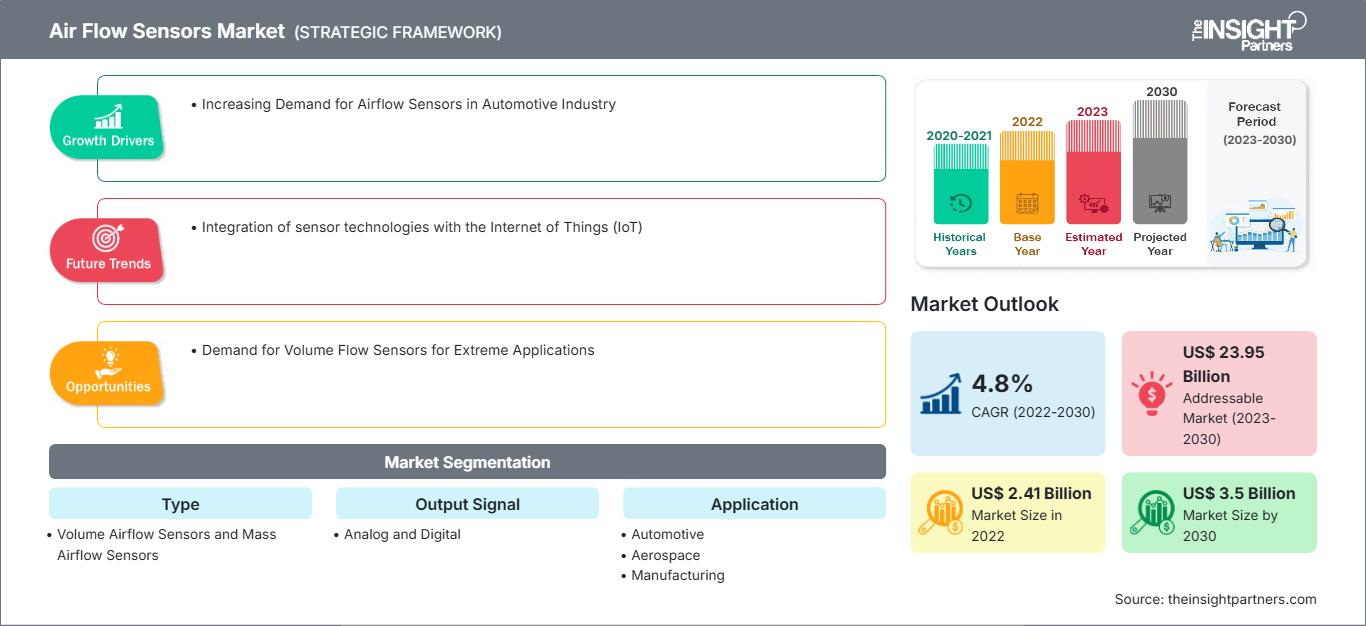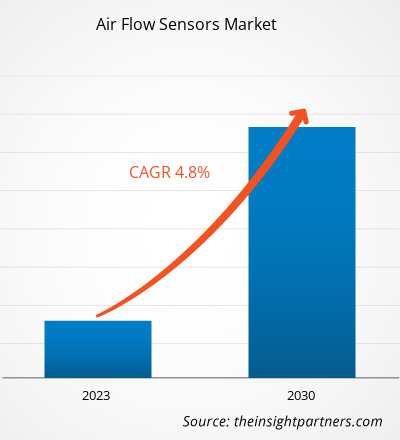预计到 2030 年,气流传感器市场规模将从 2022 年的 24.1 亿美元增至 35 亿美元。预计该市场在 2022 年至 2030 年期间的复合年增长率为 4.8%。传感器技术与物联网 (IoT) 的融合可能仍将是市场的主要趋势。
气流传感器市场分析
暖通空调 (HVAC) 系统使用气流传感器来确保高效运行并降低能耗。HVAC 系统配备气流传感器,可将该区域的实际温度与目标温度进行比较,并采取适当的措施。HVAC 控制广泛应用于各个商业领域,包括酒店、企业、零售和住宅。
气流传感器市场概览
气流传感器用于确定通道内空气的流量或质量。气流传感器分为两类:质量气流传感器和体积气流传感器。气流传感器易于安装,可测量总压力、气流静压和空气速度。气流传感器广泛应用于各种工业系统。在汽车领域,气流传感器对于保持最佳燃油效率和排放水平至关重要,并可帮助发动机控制单元调节燃油喷射,从而确保高效燃烧。
自定义此报告以满足您的要求
您将免费获得任何报告的定制,包括本报告的部分内容,或国家级分析、Excel 数据包,以及为初创企业和大学提供超值优惠和折扣
空气流量传感器市场: 战略洞察

- 获取本报告的主要市场趋势。这个免费样本将包括数据分析,从市场趋势到估计和预测。
您将免费获得任何报告的定制,包括本报告的部分内容,或国家级分析、Excel 数据包,以及为初创企业和大学提供超值优惠和折扣
空气流量传感器市场: 战略洞察

- 获取本报告的主要市场趋势。这个免费样本将包括数据分析,从市场趋势到估计和预测。
空气流量传感器市场驱动因素和机遇
汽车行业对空气流量传感器的需求不断增长,利好市场
汽车行业是空气流量传感器的主要终端用户。汽车需求的不断增长同时也推动了对空气流量传感器的需求,因为这些传感器用于发动机和排气系统,以监测和控制气流。全球汽车行业正在快速发展。此外,电动汽车在全球的普及率也在显著提高。据欧盟委员会称,汽车行业为1380万欧洲人提供了直接和间接的就业机会,占欧洲总就业人数的15.1%。根据欧洲运输与环境联合会 (EFEN) 的统计数据,英国政府承诺到 2050 年实现净零排放目标,并提议到 2035 年禁止销售所有污染车辆。因此,净零排放计划和消费者对环保汽车的需求推动了空气流量传感器市场的发展。
极端应用对体积流量传感器的需求
汽车、航空航天、制造、电力和公用事业等众多行业都对能够承受极端条件的体积流量传感器有着极高的要求。这鼓励市场参与者开发用于极端应用的体积流量传感器。例如,ENVEA 在 2023 年 9 月推出了 AirFlow P,这是一款用于极端应用的高温版本体积流量传感器。 AirFlow P 是一种用于测量灰尘负载传感器中的体积流量的传感器,适用于高达 800°C 的高温应用。
空气流量传感器市场报告细分分析
有助于得出空气流量传感器市场分析的关键细分是类型和应用。
- 根据类型,空气流量传感器市场分为体积空气流量传感器和质量空气流量传感器。体积空气流量细分市场在 2022 年占据了更大的市场份额。
- 根据应用,市场分为汽车、航空航天、制造、电力和公用事业以及其他。汽车细分市场在 2022 年占据了更大的市场份额。
按地区划分的空气流量传感器市场份额分析
空气流量传感器市场报告的地理范围主要分为五个区域:北美、亚太地区、欧洲、中东和非洲以及南非。中美洲。
日本、印度、中国、澳大利亚、新加坡、台湾和印度尼西亚等国家和地区拥有众多制造业,包括电子、食品饮料、化工、纺织、汽车和医疗保健。此外,“中国制造2025”和“印度制造”等政府举措推动了亚太地区各国这些行业的发展,从而推动了对气流传感器的需求。此外,中国的航空航天工业发展迅速。北京拥有一支技术精湛的人才队伍和年轻科学家团队,他们在嫦娥探月和天问火星探测等任务中发挥了重要作用。航空航天工业的这些发展推动了中国气流传感器市场的增长。此外,人们日益意识到空气质量监测的重要性,这也刺激了亚太地区对暖通空调系统的需求,从而使该地区的气流传感器市场受益。
空气流量传感器市场区域洞察
The Insight Partners 的分析师已详尽阐述了预测期内影响空气流量传感器市场的区域趋势和因素。本节还讨论了北美、欧洲、亚太地区、中东和非洲以及南美和中美洲的空气流量传感器市场细分和地域分布。
空气流量传感器市场报告范围
| 报告属性 | 细节 |
|---|---|
| 市场规模 2022 | US$ 2.41 Billion |
| 市场规模 2030 | US$ 3.5 Billion |
| 全球复合年增长率 (2022 - 2030) | 4.8% |
| 历史数据 | 2020-2021 |
| 预测期 | 2023-2030 |
| 涵盖的领域 |
By 类型
|
| 覆盖地区和国家 | 北美
|
| 市场领导者和主要公司简介 |
|
空气流量传感器市场参与者密度:了解其对业务动态的影响
空气流量传感器市场正在快速增长,这得益于终端用户需求的不断增长,而这些需求的驱动因素包括消费者偏好的不断变化、技术进步以及对产品优势的认知度不断提高。随着需求的增长,企业正在扩展其产品线,不断创新以满足消费者需求,并抓住新兴趋势,从而进一步推动市场增长。

- 获取 空气流量传感器市场 主要参与者概述
空气流量传感器市场新闻及最新发展
空气流量传感器市场评估是通过收集一手和二手资料后的定性和定量数据进行的,这些资料包括重要的公司出版物、协会数据和数据库。以下列出了空气流量传感器市场的一些发展:
- 领先的环境监测解决方案提供商 ENVEA 推出了其 AirFlow P 传感器系列的扩展产品,推出了一款耐高温版本,可承受高达 800°C 的温度。这款新产品扩展了 AirFlow P 传感器的功能,使其成为更具挑战性的工业应用的理想解决方案。(来源:ENVEA,公司网站,2023 年 9 月)
- Posifa Technologies 推出了其最新版本的质量空气流量传感器,该传感器将用于呼吸护理和其他医疗保健及仪器仪表领域。 PMF83000 和 PMF86000 系列传感器适用于湿度过高且腐蚀性气体含量较低的恶劣环境。(来源:Posifa Technologies,公司网站,2021 年 4 月)
空气流量传感器市场报告内容及交付成果
《空气流量传感器市场规模及预测(2020-2030 年)》报告提供了涵盖以下领域的市场详细分析:
- 空气流量传感器市场规模以及涵盖范围内所有主要细分市场的全球、区域和国家/地区预测
- 空气流量传感器市场趋势以及市场动态,例如驱动因素、限制因素和关键机遇
- 详细的 PEST/Porter 五力模型和 SWOT 分析
- 空气流量传感器市场分析涵盖主要市场趋势、全球和区域框架、主要参与者、法规和最新市场发展
- 行业格局和竞争分析涵盖市场集中度、热图分析、知名参与者和空气流量传感器市场的最新发展
- 详细的公司简介
- 历史分析(2 年)、基准年、预测(7 年)及复合年增长率
- PEST和SWOT分析
- 市场规模、价值/数量 - 全球、区域、国家
- 行业和竞争格局
- Excel 数据集
近期报告
相关报告
客户评价
购买理由
- 明智的决策
- 了解市场动态
- 竞争分析
- 客户洞察
- 市场预测
- 风险规避
- 战略规划
- 投资论证
- 识别新兴市场
- 优化营销策略
- 提升运营效率
- 顺应监管趋势




















 获取免费样品 - 空气流量传感器市场
获取免费样品 - 空气流量传感器市场